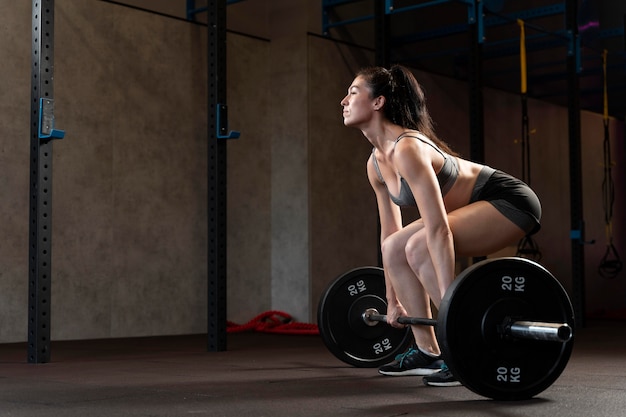
8 Ways to Improve Your Deadlift Technique, According to a Trainer
Are you a fitness enthusiast looking to take your deadlift game to the next level? Deadlifting is an incredible compound exercise that targets multiple muscle groups, but nailing the technique is crucial for reaping the maximum benefits and avoiding injuries. As a seasoned trainer, I’m here to guide you through eight powerful ways to enhance your deadlift technique and make each lift count!
Hitting the Right Form: The Foundation of a Perfect Deadlift

Before we delve into the specifics, let’s emphasize the importance of proper form. Your form sets the foundation for your deadlift journey. Maintain a strong posture with your chest up, shoulders back, and a slight arch in your lower back.
Stance and Grip: The Building Blocks
A solid deadlift begins with the right stance and grip. Position your feet hip-width apart, toes slightly turned out. For a conventional deadlift, your grip should be just outside your knees. Opt for an overhand grip or a mixed grip for more stability.
Engage Your Lats: The Power of Back Muscles
Activate your latissimus dorsi muscles by imagining you’re trying to put your armpits in your back pockets. Engaging your lats creates a stable foundation for the lift and helps prevent your back from rounding.
The Pulling Process: Lifting Like a Pro
Now that your setup is impeccable, it’s time to focus on the lifting process itself.
Push Through the Heels: The Forceful Drive
As you begin to lift the bar, remember to push through your heels. This will help engage your glutes and hamstrings effectively, allowing you to lift more weight while maintaining balance.
Maintain a Neutral Spine: The Backbone of Safety
Throughout the lift, keep your spine neutral. Avoid excessive rounding or arching, as this places unnecessary stress on your back. A neutral spine ensures that your body is properly aligned, reducing the risk of injury.
The Art of Breathing and Bracing
Proper breathing and bracing are often overlooked aspects of deadlifting. Mastering these techniques can significantly enhance your lifting performance.
Inhale and Brace: The Core Strength
Before lifting, take a deep breath, filling your diaphragm and abdomen with air. This creates intra-abdominal pressure, stabilizing your core and spine. Hold this breath throughout the lift to enhance your lifting power.
Exhale at the Top: Controlled Release
As you reach the top of the lift, exhale sharply. This controlled release of breath helps maintain core stability and ensures you’re not holding your breath under pressure.
Recovery and Rest: The Unsung Heroes
Improving your deadlift technique isn’t just about what you do in the gym; it’s also about how you recover and rest.
Prioritize Sleep: Recharge and Repair
Adequate sleep is essential for muscle recovery and growth. Aim for 7-9 hours of quality sleep each night to allow your body to repair and prepare for the next deadlift session.
Incorporate Mobility Work: Flexibility Matters
Include mobility exercises in your routine to improve flexibility and prevent muscle imbalances. Focus on hip, hamstring, and thoracic spine mobility to enhance your deadlift range of motion.
Listen to Your Body: The Ultimate Guide
As you embark on your journey to improve your deadlift technique, remember that your body is your best guide.
Deadlift:Gradual Progression: Step by Step
Avoid the temptation to lift heavy weights right from the start. Gradually increase the weight while maintaining proper form to build a strong foundation and prevent injuries.
Recognize Pain vs. Discomfort: Safety First
Learn to differentiate between muscle discomfort and pain. Pushing through pain can lead to injuries, while experiencing mild discomfort is often a part of the lifting process.
Conclusion
Mastering the deadlift technique requires dedication, patience, and a commitment to proper form. By implementing these eight strategies, you’ll not only enhance your lifting performance but also minimize the risk of injuries. Remember, every rep is an opportunity to refine your technique and become a better lifter.
FAQs
Q1: Can I deadlift with a rounded back?
A: Deadlifting with a rounded back increases the risk of injury. Always maintain a neutral spine.
Q2: How often should I deadlift to see improvement?
A: Start with 1-2 sessions per week and gradually increase as your strength improves.
Q3: Is it normal to feel sore after deadlifts?
A: Yes, some muscle soreness is normal, but sharp pain is not. Listen to your body.
Q4: Can I use lifting straps for deadlifts?
A: While lifting straps can assist with grip, focus on improving your natural grip strength first.
Q5: Should I perform warm-up sets before deadlifting?
A: Yes, warming up with lighter weights and dynamic stretches prepares your muscles for the intense lift.
Read More
Celery-Juice Benefits: Antioxidant Superfood Drink or All Hype?
Bilberries Helps Improve Eyesight and Decreases Inflammation
Tomato Nutrition: A Powerful Ally in the Fight Against Cancer and Inflammation
6 Benefits of Limes You Won’t Believe + Lime Recipes You Can Enjoy
Benefits of Cherries: What Can Cherry Nutrition Do for You?
Bell Pepper Nutrition: A Colorful Path to Health and Weight Management
Pineapple: A Tropical Delight Packed with Whole-Body Benefits
